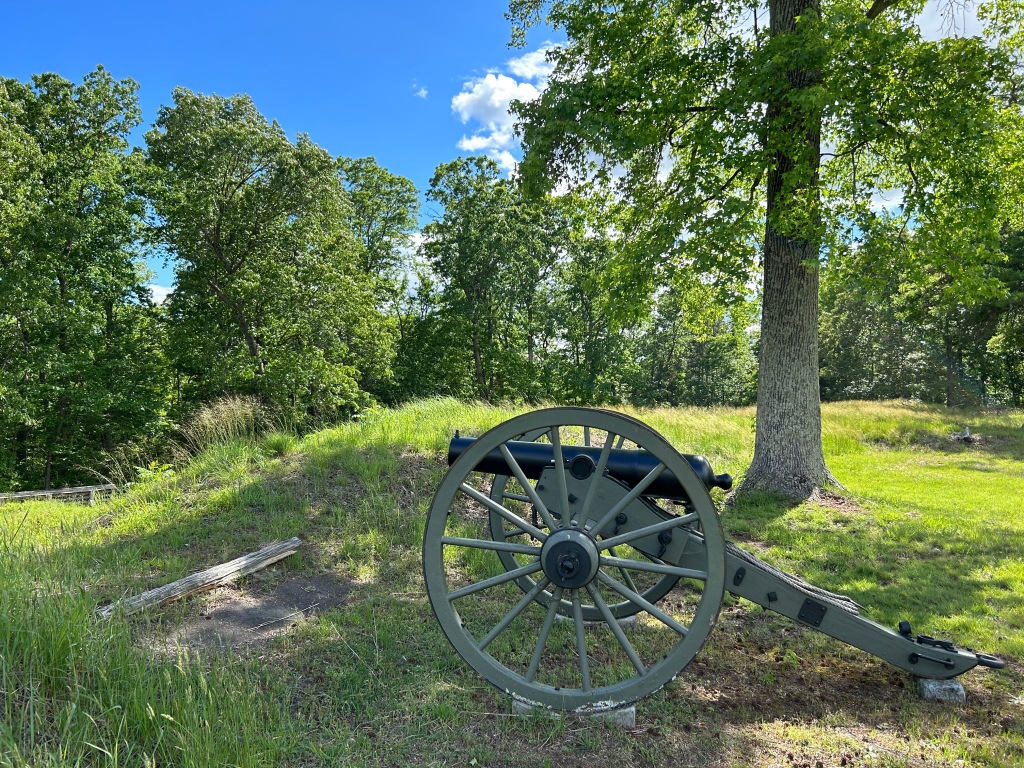
Like the Union capital, the Confederate capital was surrounded by a series of forts and fortified trenches, with one complete ring around the city and another outer line of defenses about 2/3 of the way around Richmond. The Confederate earthworks above are massive, up to 15 feet added to the tops of hills, running for miles with deep trenches. In many previous battles, the federal troops staged bloody frontal assaults on similar high-ground, well-defended positions, often losing thousands of men. Going back to the age of castles in Europe, this has proven to be a waste of human lives with little prospect for success. In the Revolutionary War, Lafayette knew that siege warfare against cannon required carefully building successive trenches at night to approach under cover. General Washington listened to him and took Yorktown using that technique.
In 1862, General McClellan tried to take Richmond, leading troops up the York River. Despite fighting at the exact same defenses around Yorktown 75 years after Washington, McClellan still relied primarily on mass frontal assaults without trench cover, revealing a dumbfounding lack of literacy. Robert E. Lee replaced the Confederate commander and executed seven days of battles that forced the Union to retreat from Virginia.
In 1864, after Spotsylvania, Grant tried again at Cold Harbor, again wasting most of 6,000 troops in an hour. Lee was prepared to defend Richmond again from another expected northeast attack, but here at Fort Harrison, Grant managed to swing his troops around to attack from the southeast in a surprise attack on 29 September 1864. General Burnham was killed, but the fort was taken. African American regiments were critical in these Union battles.
This victory gave the Union a chance to control the James River which runs through Richmond, exposing southern rail lines to Union forces, and it forced Lee to redeploy his defensive troops. If Grant could just gain one more victory at Petersburg, he could lay siege to Richmond, which was Lee’s great fear. Richmond was critical to the Confederate war effort.
Even today, Richmond is the hub of Virginia’s road and rail network. The Tredegar Iron Works—now gone—was a massive operation supplying artillery, ammunition, and armor plating for ironclad ships. The large plateau in the city housed its Chimborazo Hospital—now the site of a large park and a small medical museum—and was full of troops in various stages of recovery or not. Disease likely killed more soldiers than battle, as troops who had never been far from home suddenly congregated in close quarters. If Richmond was cut off from the south, then their ships couldn’t sail downriver, and the only safe access would be from the east without rivers, good roads or rail.
The war, blockades, lost slave labor and plantation burnings devastated the Confederate economy, and their currency was nearly worthless. If Richmond became surrounded, the Confederacy might collapse entirely. With one more victory, the war might end.
Pingback: Petersburg National Battlefield | Zero Carbon Travel
Pingback: Colonial National Historical Park | Zero Carbon Travel
Pingback: All Parks in the Mid-Atlantic, Zero Carbon | Zero Carbon Travel
Pingback: Captain John Smith Chesapeake National Historic Trail | Zero Carbon Travel
Pingback: Washington-Rochambeau Revolutionary Route National Historic Trail | Zero Carbon Travel
Pingback: Why Do We Need the NPS to Help Us Tell Our History? | Zero Carbon Travel
Pingback: All Civil War Battles, Zero Carbon Travel | Zero Carbon Travel
Pingback: All Civil War Battles, Zero Carbon Travel | Zero Carbon Travel